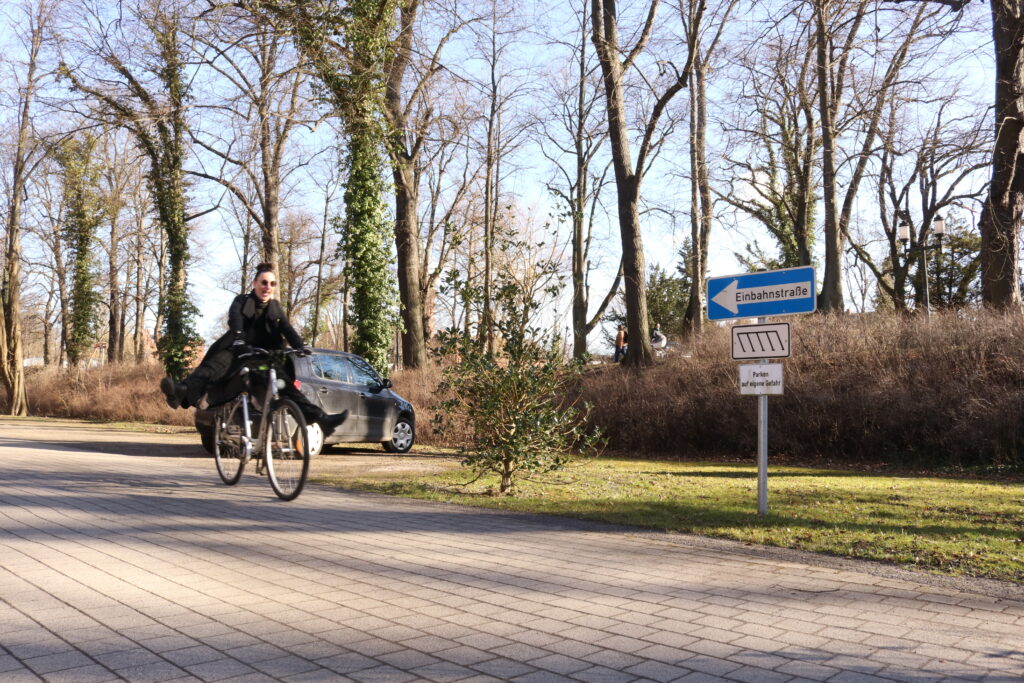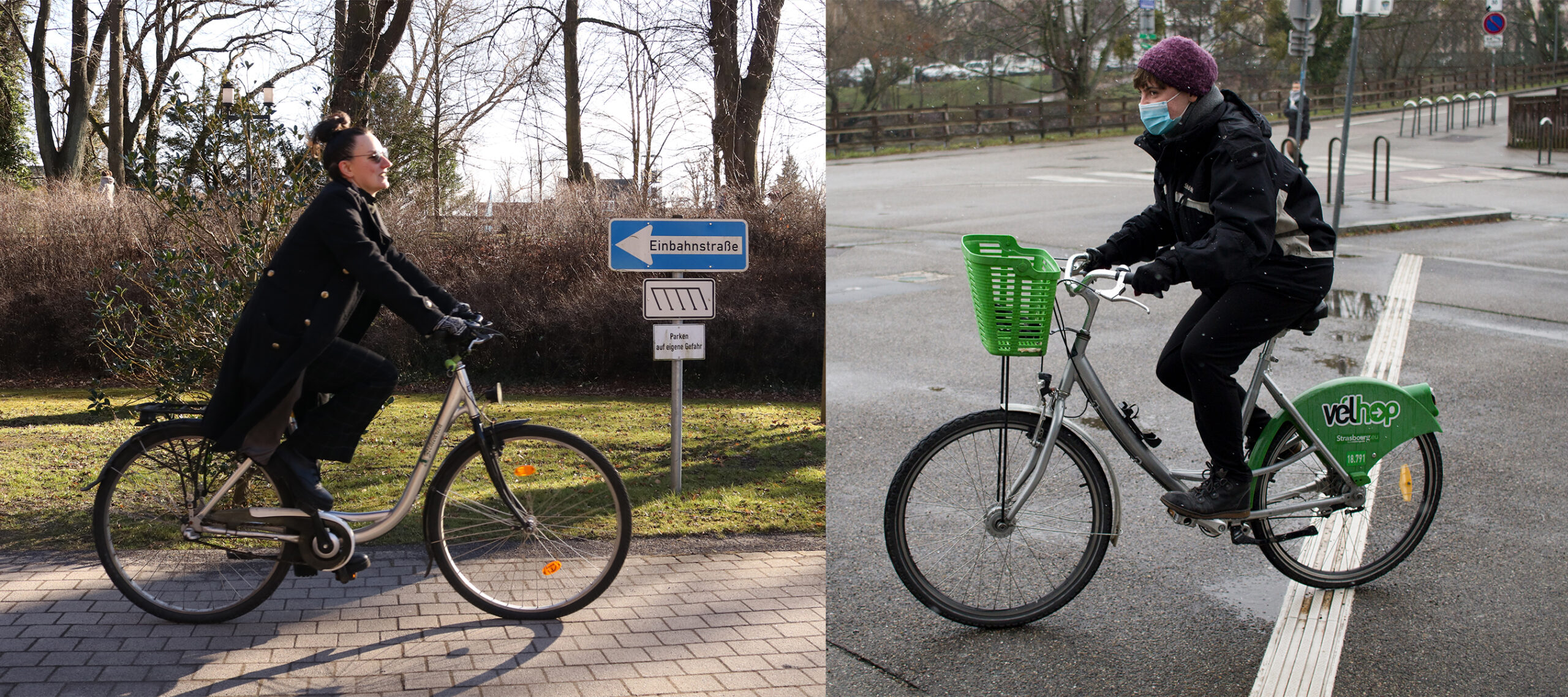“Bicycle! Bicycle! Bicycle! (…) I want to ride my bicycle, I want to ride it where I like.” sang Queen in 1978. Can’t we do it by now? In a tri national comparison between Strasbourg, Greifswald and Wageningen we are looking at how accomodating different European Cities are for cyclists.
Fahrradstadt Greifswald by Veronika Isolde Wehner
Short distances, many students and a flat surface – Greifswald is destined to be a bicycle town. And according to a study by the Center for Higher Education CHE in 2019, 93% of the students used their bike to go to university – more than in any other German city. Bicycles are visible everywhere! In Greifswald, one way to know that a new semester has started, is the abundance of identical protective coverings for the bike saddles. Local businesses and initiatives have learned that the most effective way to advertise to new students aren’t flyers, but the saddles of their own bicycles. Very handy, since the weather can change swiftly, and a wet saddle is no pleasure ride. It hardly ever is an issue if they get lost, because, like magic, new ones will appear on your bike while you are in class. In local politics, the bicycle and the infrastructure, or the lack there off, is a common and reoccurring topic. Despite Greifswald trying to advertise for an increased use of bicycles and annual participation in a national competition on most kilometers made by bicycle per town, here the bicycles are lowest in the perceived hierarchy in traffic. The bicycle lanes on the main roads are often extremely narrow, filled by parked delivery vehicles and often ignored by the car drivers. In a survey, done in 2018 by the Institute for Geology in the University of Greifswald, the most common obstacle to cycling was the (car)traffic on the most frequented roads. Bicycle rallies in Greifswald are also a popular form of political activism. To claim visibility in traffic, the grassroot-movement critical mass regularly rides on the main roads as a cluster, on occasion together with the local Fridays for Future-demonstrations.
In Greifswald, the police authorities have a passion for stopping cyclists. Riding on the wrong side of the street, intoxicated or without functioning lights are fined. Random police controls are often publicized via the anonymous app Jodel, so that party goers can avoid them later. Recently, a secure bike-parking facility at the local train station, that was planned in 2014, was finished. Good news for anyone who does not want their bike to get stolen by the infamous bike mafia.
Still, the bicycle is one of the most convenient and inexpensive ways to get around town and the area. Especially in summer, when the outskirts of the Baltic Sea are just 20 minutes away.
3 out of 5 points.
Veloville Strasbourg by Anne Frieda Müller
“Everyone is actually using bikes to get somewhere!”, a French friend of mine once said about Strasbourg. And yes, I agree. Bikes are everywhere in the city. And they are way more aggressive than cars. You can hear the ringing bikes everywhere at all times– at the river Ill or at the Rhine or in the city centre – bikes trying to go around pedestrians. Actually, going through the city by bike is possible without annoying pedestrians in pedestrian zones: according to the website francevelotourisme.com there are 560 kilometres of cycle paths in the region. And a lot of one-way streets can be used for both directions by bikes, especially small streets just around the city centre.
According to this article by LeParisien in 2015, 16 per cent of employed people got to their offices by bike in Strasbourg. This doesn’t seem like a lot at first, but in France it is the highest rate of cyclists per city. The Alsace region is also very well known for their bike tourism, there are three EuroVelo routes going through Strasbourg. Those routes can be used for bike tourism all around Europe. And just around the city, there are a lot of possibilities for smaller bike adventures like going to the Rhine, through forests or to some lakes (Baggersee, for my German friends ;)). Most times, the cycle paths are made of concrete, which makes cycling very comfortable. And even though there are two big chains of mountains around, the Black Forest and the Vosges, the valley of the Alsace is at ground level and doesn’t have a lot of hills.
In the city Strasbourg itself, there are some minor dangers such as tram rails, in which you don’t want to get stuck in with your wheels. Plus, in some neighbourhoods and in front of some bridges, there are special balustrades, so bikes have to go around them and slow down. And of course, there are cars everywhere and car drivers don’t always pay attention to bikes, but in Strasbourg they still do way more than in other big French cities such as Paris for example.
My conclusion after some experience of going by bike which I also rented without problem, around Strasbourg is: the city infrastructure is well made for bikers, the weather is almost always sunny and great for bike tours and despite some inattentive car drivers it is really safe to go around Strasbourg by bike. 3.5/5 bike points.
Fietsstad Wageningen by Veronika Isolde Wehner

There might be 9 Billion Bicycles in Beijing, (according to Katie Melua ), but the Netherlands are THE bicycle-nation in the EU. Every Dutch citizen owns an estimated 1,3 bicycles – more than any other nation in the world. It makes sense – a country that is literally called low has very few hills in the overall topographic surface which makes riding a bike less of a sport and more of a convenient means of transportation. Work, shopping, school, meetings and appointments, everything is done by fiets. The environmental aspect, although present, is not the main reason for the high usage. Here, the bike is an important component of public health and a means for the accessibility of city centers. The typical Dutch bike is of a heavy frame, with few, if non, gears. It is perfect to transport children, beer crates, furniture, or your drunk friends without losing stability.
Newcomers to Wageningen, a small university town in the Province of Gelderland, will swiftly realise that the broad well-lit bicycle paths, usually separated from the main road by a line and sometimes physical barriers, have rules of their own. According to the Central Statistics Bureau Netherlands, the CBS, citizens in Gelderland cycled on average 3,3 km per day in 2019, slightly more, than the national average. Any bicycle is indeed king of the roads in Wageningen. It takes preference over cars and pedestrians alike. It is crucial to be so secure on a bike that two or three people can cycle next to each other. The commute to work or university is much better with a relaxed chat, knee-to-knee while cycling. Wageningen university is home to students from all over the world and not everybody knows how to ride a bike – yet. It is not uncommon, to see adults taking their first bicycle lessons in front of the student housing. Once they master the first hurdle, not falling off, they can rent a bike from the Erasmus Student Network or the Wageningen bike-share-business Cykle, founded by a Wageningen student and ranked number 22 on trouw’s annual list of the 100 greenest Dutch in 2019. Or get straight into the vibrant unofficial second-hand-social-media-market for bikes by graduates leaving the country again. To make their own bicycle stand out, many students decorate theirs with artificial flowers or vibrant colors. A special challenge is the fact that many bicycle roads are shared with mopeds, which are significantly faster and often interrupt the flow of the traffic. Since the local police does not have too much to do and is on bicycles themselves, they can and will fine cyclists for a lack of proper lights, intoxication and holding electronic devices in your hand. Listening to music, however, is not prohibited. On the way to university students will have the chance to check their phone regardless, since the biggest traffic jams in town are on the bicycle lanes on the way to the main campus.
5 out of 5 points
Photos taken by Sophie Loebjinski and Kim.

